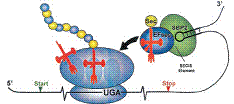Biochemistry, Department of

Vadim Gladyshev Publications
Document Type
Article
Date of this Version
November 2005
Abstract
Selenium is an essential trace element with potent cancer prevention activity in mammals. The 15-kDa selenoprotein (Sep15) has been implicated in the chemopreventive effect of dietary selenium. Although the precise function of Sep15 remains elusive, Sep15 copurifies with UDP-glucose:glycoprotein glucosyltransferase (GT), an essential regulator of quality control mechanisms within the endoplasmic reticulum. Recent studies identified two GT and two Sep15 homologues in mammals. We characterize interactions between these protein families in this report. Sep15 and GT form a tight 1:1 complex, and these interactions are conserved between mammals and fruit flies. In mammalian cells, Sep15 co-immunoprecipitates with both GT isozymes. In contrast, a Sep15 homologue, designated selenoproteinM(SelM), does not form a complex with GT. Sequence analysis of members of the Sep15 family identified a novel N-terminal cysteine-rich domain in Sep15 that is absent in SelM. This domain contains six conserved cysteine residues that form two CxxC motifs that do not coordinate metal ions. If this domain is deleted or the cysteines are mutated, Sep15 no longer forms a complex with GT. Conversely, if the cysteine-rich domain of Sep15 is fused to the N-terminus of SelM, the resulting chimera is capable of binding GT. These data indicate that the cysteine-rich domain of Sep15 exclusively mediates protein-protein interactions with GT.


Comments
Published in THE JOURNAL OF BIOLOGICAL CHEMISTRY VOL. 280, NO. 45, pp. 37839–37845, November 11, 2005.